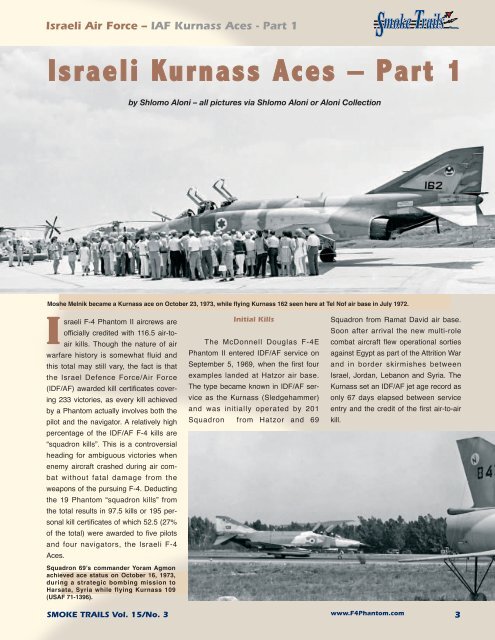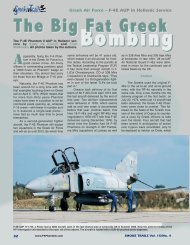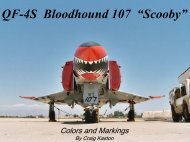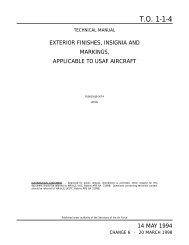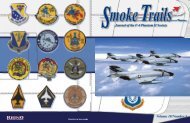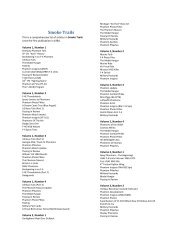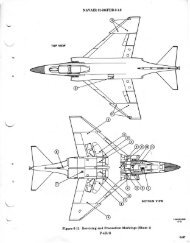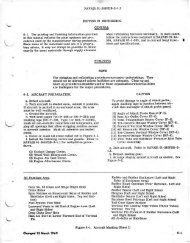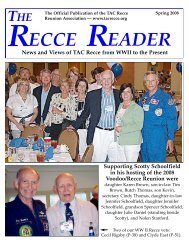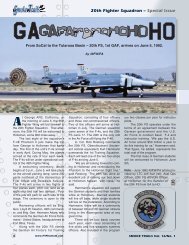Israeli Kurnass Aces – Part 1 - F-4 Phantom II Society
Israeli Kurnass Aces – Part 1 - F-4 Phantom II Society
Israeli Kurnass Aces – Part 1 - F-4 Phantom II Society
Create successful ePaper yourself
Turn your PDF publications into a flip-book with our unique Google optimized e-Paper software.
<strong>Israeli</strong> Air Force <strong>–</strong> IAF <strong>Kurnass</strong> <strong>Aces</strong> - <strong>Part</strong> 1<br />
<strong>Israeli</strong> <strong>Kurnass</strong> <strong>Aces</strong> <strong>–</strong> <strong>Part</strong> 1<br />
Moshe Melnik became a <strong>Kurnass</strong> ace on October 23, 1973, while flying <strong>Kurnass</strong> 162 seen here at Tel Nof air base in July 1972.<br />
<strong>Israeli</strong> F-4 <strong>Phantom</strong> <strong>II</strong> aircrews are<br />
officially credited with 116.5 air-toair<br />
kills. Though the nature of air<br />
warfare history is somewhat fluid and<br />
this total may still vary, the fact is that<br />
the Israel Defence Force/Air Force<br />
(IDF/AF) awarded kill certificates covering<br />
233 victories, as every kill achieved<br />
by a <strong>Phantom</strong> actually involves both the<br />
pilot and the navigator. A relatively high<br />
percentage of the IDF/AF F-4 kills are<br />
“squadron kills”. This is a controversial<br />
heading for ambiguous victories when<br />
enemy aircraft crashed during air combat<br />
without fatal damage from the<br />
weapons of the pursuing F-4. Deducting<br />
the 19 <strong>Phantom</strong> “squadron kills” from<br />
the total results in 97.5 kills or 195 personal<br />
kill certificates of which 52.5 (27%<br />
of the total) were awarded to five pilots<br />
and four navigators, the <strong>Israeli</strong> F-4<br />
<strong>Aces</strong>.<br />
Squadron 69’s commander Yoram Agmon<br />
achieved ace status on October 16, 1973,<br />
during a strategic bombing mission to<br />
Harsata, Syria while flying <strong>Kurnass</strong> 109<br />
(USAF 71-1396).<br />
SMOKE TRAILS Vol. 15/No. 3<br />
by Shlomo Aloni <strong>–</strong> all pictures via Shlomo Aloni or Aloni Collection<br />
Initial Kills<br />
The McDonnell Douglas F-4E<br />
<strong>Phantom</strong> <strong>II</strong> entered IDF/AF service on<br />
September 5, 1969, when the first four<br />
examples landed at Hatzor air base.<br />
The type became known in IDF/AF service<br />
as the <strong>Kurnass</strong> (Sledgehammer)<br />
and was initially operated by 201<br />
Squadron from Hatzor and 69<br />
Squadron from Ramat David air base.<br />
Soon after arrival the new multi-role<br />
combat aircraft flew operational sorties<br />
against Egypt as part of the Attrition War<br />
and in border skirmishes between<br />
Israel, Jordan, Lebanon and Syria. The<br />
<strong>Kurnass</strong> set an IDF/AF jet age record as<br />
only 67 days elapsed between service<br />
entry and the credit of the first air-to-air<br />
kill.<br />
www.F4<strong>Phantom</strong>.com<br />
3
Squadron 69’s commander Yoram Agmon<br />
achieved ace status on October 16, 1973,<br />
during a strategic bombing mission to<br />
Harsata, Syria flying <strong>Kurnass</strong> 109 (USAF 71-<br />
1396).<br />
Though possessing roughly similar<br />
air combat aerodynamic performance to<br />
the then IDF/AF air-to-air platform, the<br />
Dassault Mirage <strong>II</strong>ICJ known in IDF/AF<br />
service as the Shahak (Skyblazer) <strong>–</strong> the<br />
big fighter-bombers from the United<br />
States primarily flew air-to-ground missions.<br />
Yet in one aspect of air combat<br />
the <strong>Kurnass</strong> was vastly superior to the<br />
Shahak. The combination of the<br />
AN/APQ-120 radar, the AIM-7 Air-to-Air<br />
Missile (Sparrow AAM) and the navigator<br />
offered the <strong>Kurnass</strong> superior all<br />
weather and Beyond Visual Range<br />
(BVR) attributes. This resulted in the<br />
allocation of the nighttime Quick Reaction<br />
Alert (QRA) mission to the <strong>Kurnass</strong><br />
force and in the introduction of mixed<br />
formations with a <strong>Kurnass</strong> pair leading a<br />
Shahak pair on certain high priority airto-air<br />
missions. The leading <strong>Kurnass</strong> aircrews<br />
scanned the radarscopes for<br />
enemy aircraft, while the trailing Shahak<br />
pilots searched the sky to visually<br />
acquire the hostile fighters.<br />
Between September 5, 1969, and<br />
August 7, 1970, the day the Attrition War<br />
Moshe Melnik graduated<br />
from the IDF/AF Flying<br />
School Class 54 in<br />
November 1967. Following<br />
assignment to the<br />
Ouragan OTU he flew the<br />
A-4 Skyhawk from April<br />
1968 until October 1970.<br />
He was then posted to fly<br />
the <strong>Kurnass</strong> with<br />
Squadron 119. This photo<br />
beside the unit’s flagship<br />
<strong>Kurnass</strong> 119 was taken in<br />
December 1970. In 1976,<br />
Melnik was among the<br />
first group of IDF/AF<br />
pilots to be converted to<br />
the F-15 and three years<br />
later he was the first pilot<br />
to be credited with an F-<br />
15 kill.<br />
ended, the <strong>Kurnass</strong> squadrons were<br />
credited with seven kills compared with<br />
67 kills credited to the Shahak community.<br />
The pendulum began to swing in<br />
favour of the big fighter-bomber during<br />
the inter-war years between the end of<br />
the Attrition War and the start of the Yom<br />
Kippur War (YKW) on October 6, 1973.<br />
Limited-scale operations resulted in a<br />
higher percentage of the <strong>Kurnass</strong> force<br />
available for air-to-air missions than<br />
could be expected during a war when<br />
the <strong>Kurnass</strong> force was to fly demanding<br />
air-to-ground missions. Fully exploiting<br />
the situation, a total of 19 kills were<br />
<strong>Israeli</strong> Air Force <strong>–</strong> IAF <strong>Kurnass</strong> <strong>Aces</strong> - <strong>Part</strong> 1<br />
credited to the <strong>Kurnass</strong> squadrons during<br />
this timeframe compared to 14 kills<br />
credited to the Shahak fighters.<br />
The First <strong>Kurnass</strong> Ace<br />
The <strong>Israeli</strong> government decision to<br />
avoid a pre-emptive strike on October 6,<br />
1973 possibly generated the required<br />
environment for the emergence of the<br />
first three <strong>Kurnass</strong> aces. Instead of<br />
bombing enemy targets, the <strong>Kurnass</strong><br />
force was heavily committed to the frustration<br />
of the Arab air offensive. The<br />
<strong>Kurnass</strong> aircrews were credited with 23<br />
4 www.F4<strong>Phantom</strong>.com SMOKE TRAILS Vol. 15/No. 3


